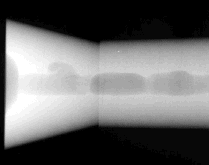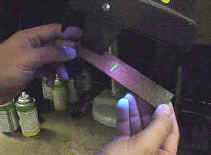 |
|
Radiograph of
Solidification Shrinkage in a Casting |
|
X-ray
Radiography is a technique of producing a photographic image of an
opaque specimen by the penetration of X-ray radiation.
-
When an X-ray beam
of radiation is transmitted through any heterogeneous object, it is
differentially absorbed, depending upon the varying thickness,
density, and chemical composition of this object.
-
The image
registered by the emergent rays is recorded on photographic
film. fluorescent screen, or digital media.
-
The X-ray radiograph is a useful tool for examining metals castings for
porosity, cracks, inclusions, or voids. (Reference -
ASTM radiographic standards)
|
 |
|
Dye Penetrant Showing
a Crack under UV Illumination |
|
Liquid
dye penetrant inspection is used to identify
surface cracks and flaws.
-
In this
method a low surface tension liquid dye fluid penetrates
by capillary action into clean and dry surface-breaking
discontinuities.
-
After
adequate penetration time has been allowed, the excess penetrant is
removed, and a developer is applied to give a visible indication of
any flaws at the penetration sites.
-
Inspection
is performed under ultraviolet or white light, depending upon the type
of dye used - fluorescent or nonfluorescent (visible). (Reference
ASTM E165 and E1417)
|